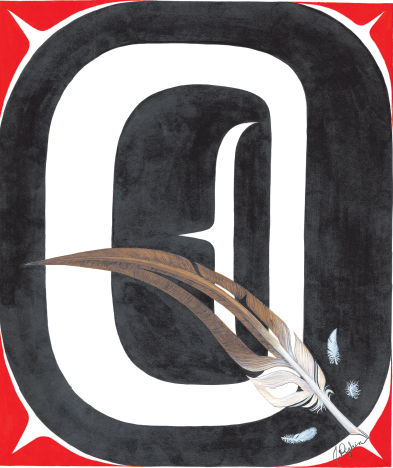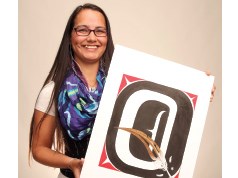The letter Q has an odd relationship with Dakelh.
The sound it makes is there in the phonetic speaking of this region's 10,000-year-old language, but the writing of that language is much younger. It was done by incoming Europeans, and the letter makes no appearance in any written version of Dakelh. The letters "kw" have been substituted by colonial writers. The Dakelh word for fire could theoretically have been spelled "qu'un" but was arbitrarily spelled "kwun" by the first colonial writers trying to get Dakelh down on paper.
When one of this region's most acclaimed artists, Jennifer Annas Pighin, was assigned the letter Q as part of the Alphabet Project, the irony of it struck her immediately. She is a former elected councillor of the Lheidli T'enneh First Nation, she is a leading member of the growing team of aboriginal teachers in the area, and is striving to learn the region's mother tongue from family elder Edie Frederick and others of the few remaining speakers of Dakelh.
"Dakelh contains 45 sounds and does not have P, R, F, V, Q or X," Pighin said.
"I do like the letter Q. I love its shapes and lines," Pighin said. "When I found out Q was my letter, I had an immediate vision in my head of how it was going to look. That is not what came out."
Flip through the below slideshow to view the Alphabet Project art and a link to each artist story:
The one thing she did mentally insist for herself was that somehow, some way, the Alphabet Project painting she did was going to represent her traditional language. It was a cultural imperative, she felt, but also an exciting challenge since there is no original written form of Dakelh. The syllabics images sometimes used, like the symbols installed over the door to the Canada Winter Games office, is as Euro-created as the standard English alphabet, she said, so working a traditional image around one of the Euro symbols was not easy.
Q stands for quill, she kept thinking, and when those first Europeans passed through the Lheidli region, the quill would have been one of their main writing tools. In the image of quill pen, she found the symbolic bridge she was yearning for.
"The quill would have been a writing tool even when The Citizen started 100 years ago, and that is why we are doing the Alphabet Project in the first place," she said. "It has that 'kw' sound, it has that acknowledgment of language and how it lives. Prior to colonization, all Dakelh language lived in oral form until that pen, that quill, brought writing."
One could celebrate the quill as a tool of permanence, allowing the Dakelh language to be enshrined forever. That may still be the way the story ends, but the Lheidli T'enneh First Nation's story has another chapter and it makes the quill, the pen, the written word, the act of education itself, into something of a horror.
The occupation of this territory, like most of the rest of Canada, put a sinister twist on learning. Aboriginal communities, whether they had a treaty or not, whether they were willing participants or not, were subjected to a government-led and church-led campaign of cultural attrition. In recent years, modern culture has deemed this action an attempted genocide and issued numerous apologies.
Residential school is now a phrase tantamount to institutionalized trauma. Its effects were, among other things, the systemic destruction of the traditional aboriginal family and systems of aboriginal community.
It was not the only agent of this brutality, and some of it continues to operate in the form of federal laws like The Indian Act, but convinced several generations of aboriginal people to hate and even fear school itself.
Pighin mulled all these issues, and chipped away on details that represented them, until she could come up with the overall image that would surround the quill foundation of the painting. She started with an easy one: the primary representative animal image of the Lheidli people is the eagle. Thus, the quill pen in her painting is an eagle feather.
That feather is riddled with holes. These stand for the gaps in colonial-aboriginal knowledge and governance. Neither side is perfect, and both are slowly bringing aspects of the other into their way of living life. Respecting each other's spaces and letting each other form a greater beauty together is bringing both ways of being closer together, she symbolically explained.
A puff of down - three wisps of eagle under-feather - are floating in the background air. This, too, has heavy iconic weight.
"In the traditional balhats system - sometimes you hear the word potlatch, and that is not our Dakelh word of it, but that's what we call the balhats system, the feast hall system - when important community business was done, it was at a big gathering, and when it was all finished and the deal was finalized, eagle down was blown into the air. That was the signal to everybody that the contract was signed. Blowing the eagle down was, in an oral culture, the same as writing it into permanence, because people remembered that act of blowing the eagle down. It became part of the oral record when that happened."
Pighin can remember when her artistic senses began to sharpen. She was not surrounded by artists in her life, but there was a strategic one who sparked some childhood inspiration. Her neighbour at their house alongside the Nechako River was skilled painter Victor Morris and watching him work gave her the first sense of that special skill.
Also, her cousin Jana Bester Campbell loved to colour with her and that simple girlhood pleasure also planted some seeds. Even scratching lines in the sand is a memory that wasn't washed away.
But her future really took a tumble into place when, at an age she can't remember but a moment she can't forget, she took hold of some berries, smooshed them in her fingers, and used them to draw on some birch bark. "And it worked," she said. "And I realized right away that different coloured berries made different coloured marks."
With the encouragement of her family members, most notably Robert and Edie Frederick, now respected elders in the Lheidli T'enneh community, she started to develop a consciousness about making art. She gravitated to the work of masters Ted Harrison and Roy Henry Vickers, she ate up the high school lessons of a pivotal art teacher Don Leech, her mother Marie was a teacher and gave her every indication that art was a worthwhile profession so she attended Emily Carr University of Art + Design.
Now, Pighin is both artist and teacher, with a large dose of community advocate and volunteer plopped on top.
Her reputation has become enormous thanks to numerous examples of public art, her designs for Team BC at the 2015 Canada Winter Games, more for the main Games organization (including the gold, silver and bronze medals), many public art events, and lead roles in transformative cultural activities like a UNBC course in building cottonwood canoes, construction of the first pithouse in modern Lheidli history, and the city's primary aboriginal drum group.
Now, that reputation has grown substantially - the size of one letter Q.




